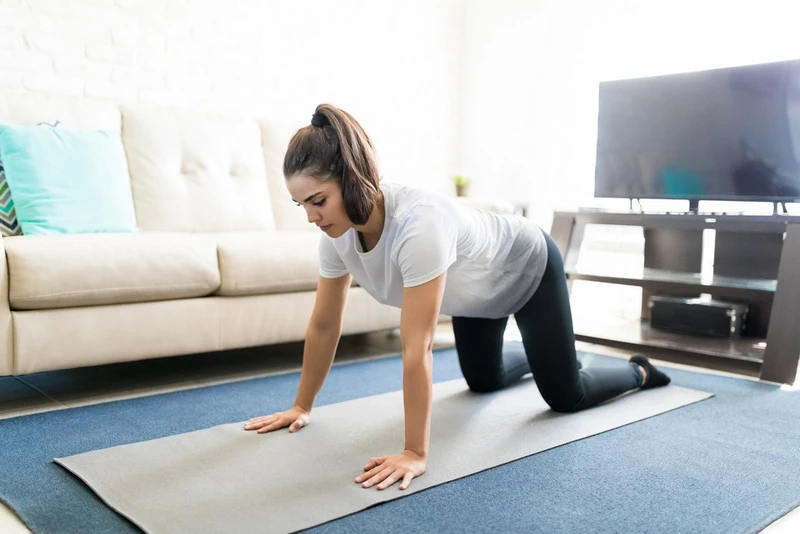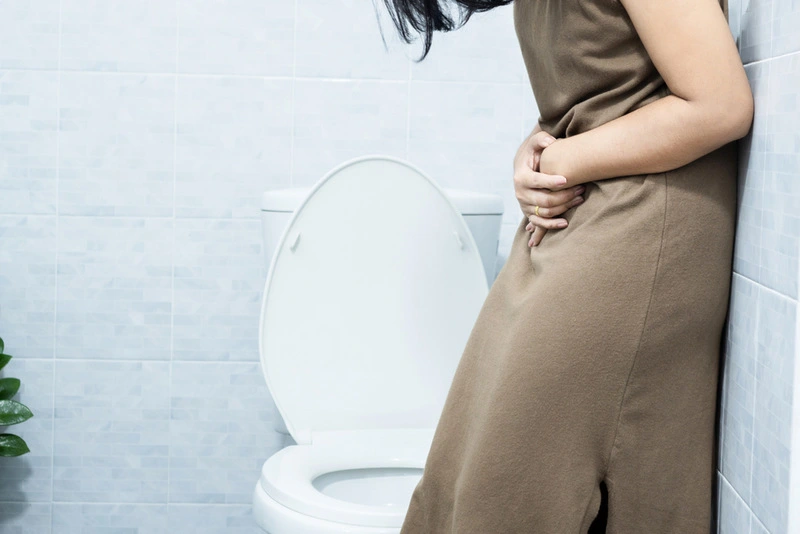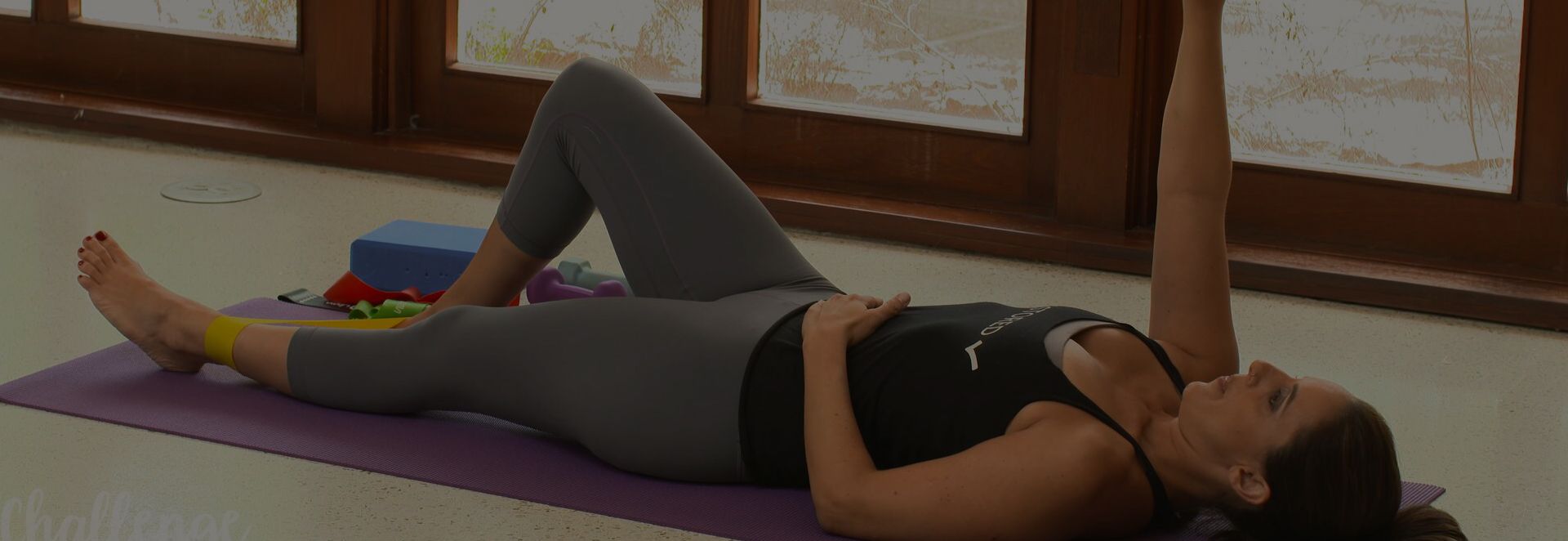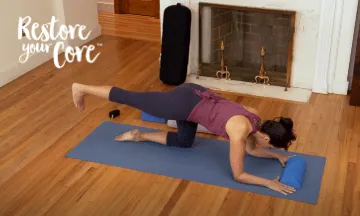Resources
Leak Pee Solutions: Managing Urinary Incontinence
By Lauren Ohayon 01/15/2024
4 Min Read
Explore solutions for leak pee issues, including causes, symptoms, and effective exercises for urinary incontinence, to improve bladder control and health.
Table of Contents
LEAK PEE
Leaking of any form sucks, but leaking pee is especially annoying and sometimes embarrassing. It’s a common problem and, sadly isn’t just a little pesky nuisance that’ll go away if you ignore it. Ignoring urinary leakage may actually lead to more complicated issues in the future, making it harder to manage. The severity of urinary incontinence ranges from a small leak when you sneeze, jump, or cough to sudden uncontrollable urges to urinate that make it difficult to get to the bathroom in time.
Many fitness and health gurus will, most likely, recommend kegels or exercises that contract or tighten your pelvic floor. However, it isn’t always an issue with your bladder or pelvic floor muscles. Yes, they may be affected or may be presenting the more noticeable symptoms, but more often than not, urinary incontinence is a whole body issue.

What is Urinary Incontinence?
Urinary incontinence is a loss of bladder control that affects people in different ways. The most common types of urinary incontinence include stress incontinence and urge incontinence — an overactive bladder. Incontinence is likely to affect approximately twice as many women as men. This is most often due to pregnancy, childbirth, and menopause. Pregnancy stresses and strains the muscles in the pelvic region, which may often lead to stress incontinence. However, urinary leakage is not a normal or natural part of aging and is often a sign of an imbalance in the body.
Urinary incontinence/leakage
If you are suffering from urinary leakage, the chances are that this issue is part of a whole body imbalance. No need to freak out! A whole body imbalance merely means that incontinence is not about your pelvic floor alone. It is about the container that your pelvic floor lives in. Your body. Treating the pelvic floor alone (Kegels) is symptom-targeted rather than root cause.
Trying to treat symptoms in isolation does not allow you to truly identify and correct the source of the imbalance. Often, the symptoms we notice do not originate in the affected area. Just like a foot injury may eventually lead to leg, hip, butt, and back pain, urinary incontinence can be a symptom that did not originate in the pelvic floor.
Symptoms of Urinary Incontinence
Some of the most common symptoms of bladder incontinence are:
-
- Leaking urine during exercise, lifting, bending, or other daily activities
-
- Sudden and strong oncoming urge to urinate
-
- Urinating without warning or feeling of urgency
-
- Urinating in your sleep
-
- Difficulty holding urine or making it to the restroom in time
-
- Recurrent urinary tract infections
Why is My Bladder Leaking all of a Sudden?
Urinary incontinence can happen for various reasons. However, it is not always a sign of something severely wrong. Often, the case may be related to changes your body undergoes during or post pregnancy or imbalances in your body.
Some of the more common causes include:
Pregnancy:
Hormonal shifts and imbalances, as well as your growing baby adding pressure to your bladder and pelvic floor, may lead to incontinence.
Childbirth:
A vaginal delivery may weaken the muscles required to control urination as well as lead to other issues, such as pelvic organ prolapse.
Aging:
Although incontinence is not a normal part of aging, the muscles may become weaker with age and bladder contractions may become more frequent as you get older.
Menopause:
During menopause, your body undergoes a lot of hormonal and physical changes. These changes may aggravate incontinence.
Hysterectomy:
A woman’s uterus and bladder depend on many of the same muscles, ligaments, and structures for support. Any surgical procedure that may involve or compromise a woman’s reproductive system may damage the pelvic floor and supporting muscles and ligaments, which can lead to incontinence.
Enlarged prostate:
In men, an enlarged prostate can lead to male incontinence.
What are the Types of Urinary Incontinence?
The common types of incontinence include:
-
- Stress incontinence — More common in pregnancy or those who delivered vaginally. May be triggered by coughing, laughing, bending, lifting, jumping, or sneezing.
-
- Urge incontinence — More often an issue with aging and characterized by increased urinary frequency and urgency (overactive bladder)
-
- Overflow incontinence — Overflow incontinence is characterized by dribbling urine, increased frequency of urination, and inability or feeling of incompleteness after urinating.
-
- Mixed incontinence — It is possible to experience a combination of the symptoms and types mentioned above.
How Do You Treat Leaking Urine?
Most often, surgical or medical procedures are unnecessary for treating urinary incontinence. Exercise and movement treatments have helped many people find relief from urinary leakage and regain bladder control.
Below are a few exercises I teach in my program to help control the flow of urine.
Candles/Core Engagement:
-
- Lie on your back with your knees bent and feet flat on the floor.
-
- Inhale deeply through your nose, expanding the ribs.
-
- Exhale slowly through your mouth, imagining you’re blowing out 100 candles on a birthday cake.
-
- Focus on making the exhale longer than the inhale, promoting relaxation and feeling your core respond.
-
- Repeat the inhale-exhale cycle for several breaths.
This can and should be practiced whenever working out and managing a load, a weight, or a core move. This helps the core to be reflexive and promotes optimal engagement as your core responds to your breathing.
Seated Side Bend:
-
- Sit in a chair or kneel if that feels more comfortable. Consider sitting on a block or some pillows to keep your spine in neutral
-
- Hold a yoga strap or belt overhead. Bend your elbows slightly to take the stress off of your neck and shoulders.
-
- Exhale, blow candles (as above), tighten your core and side bend right. Come back to the center, then exhale to go left.
-
- Your core should not bulge, brace or push out as you do these.
These are great for upper body mobility, torso length and strength and are a great way to work your core without strain.
Cat Cow:
-
- Begin on your hands and knees, line up your wrists underneath your shoulders and your knees underneath your hips.
-
- Exhale as you round your spine, tucking your chin to your chest and draw your navel toward your spine, rounding your entire back.
-
- Feel the stretch along your spine, especially in the lower back, as you tuck your pelvis under you.
-
- On an inhale, push your hands into the floor and “as if” drag them towards your knees as you lift your chest up, feeling the contraction in the upper back. and a stretch across the front of your chest.
-
- Exhale for Cat (rounded back) and inhale for Cow (arched back).
-
- Flow between Cat and Cow, coordinating your breath with each movement.
-
- Repeat the flowing movement for several breaths, moving at a pace that feels comfortable for you.

Wide Leg Stretch:
-
- You may need a chair or stool for this movement
-
- Face the stool and open your legs wide
-
- Bend forward from your hips, keeping your spine long (don’t round or arch your back)
-
- Place your hands on the stool, blocks, or floor – whichever allows you to keep your spine in neutral
-
- Shift your hips to the right; your right hip will lift higher as you shift right, and your legs are straight. Feel free to bend your right knee if you are doing this movement for the first time.
-
- Pause and enjoy the deep groin stretch.
-
- Now shift your hips to the left and sink into this stretch.
-
- Move from side to side, staying for a few breaths on each side and feeling that deep stretch.
-
- Your hips should hike up and down rather than moving from side to side — ensure it’s a hip joint movement.
Wide Leg Stretch and Twist:
-
- Get Into the same position as the wide leg stretch above.
-
- Take your right arm and straighten it above your head as you twist your upper body to the right
-
- Repeat on the other side.
-
- Repeat a few times on each side.
Pelvic Clock:
-
- Lie on your back with your knees bent and your feet flat on the floor.
-
- Imagine that your belly button is 12 o’clock and your pubic bone is 6 o’clock, and there is a straight line between the two.
-
- Using small movements with your pelvis only, tuck and untuck your pelvis as you trace that straight line between 12 o’clock and 6 o’clock.
-
- Ideally, you should be able to generate movement from your pelvis, not using your feet.
-
- Repeat 8 times, then start to recruit your feet and other muscles, making the movement larger.
-
- Repeat this larger movement 8 times, then go back to the quiet movement of your pelvis only 8 times.
-
- Now move on to 3 o’clock to 9 o’clock — side to side movement in your pelvis
-
- Try to keep your knees still; they might want to sway from side to side like windshield wipers but try to keep them quiet
-
- After 8 rounds, make the movement bigger and allow your knees to follow along.
-
- Then go back to 8 more rounds of just the pelvis moving
-
- Next, move your pelvis clockwise around the whole clock. Start at 12 o’clock and slowly move your pelvis through each hour on the clock face.
-
- Then go anticlockwise from 12 to 11, then 10 etc
-
- Alternate clockwise and anticlockwise 8 times — only using your pelvis
-
- As before, now make the movement harder and larger, using all the muscles that surround your pelvis — repeat 8 times.
-
- Go back to gentle movements just from your pelvis and repeat 8 times.
-
- Finally, the diagonal lines. Start with 5 o’clock to 11 o’clock, drawing the line with your pelvis only and repeat 8 times.
-
- Now 2 o’clock to 7 o’clock 8 times
-
- As before, make the movement bigger 8 times on each diagonal, then go back to the small movements 8 times.
Try and notice which movements were easier and if any of them were sticky or harder. This is a great way to assess your pelvis and gives you lots of information about where your weak or sticky spots might be.
Glute Bridge:
-
- Lie on your back, knees bent, and feet flat on the floor.
-
- Tilt your pubic bone gently toward your belly button, flattening your lower back to the floor.
-
- Push your feet into the floor to lift your pelvis slowly while maintaining the pelvic tilt.
-
- Keep your ribs on the floor, focusing on feeling the exercise in your glutes.
-
- Repeat 6-8 times.
Remember to start every movement with candles exhale.
When To Seek Medical Advice
While urinary continence can usually be treated effectively with exercises like the ones suggested above, there are some circumstances when a professional assessment is required.
If you find yourself experiencing more frequent episodes of urinary leakage or losing a higher volume of urine, please seek medical advice from your primary healthcare provider.
If you get to a stage where your urinary incontinence is seriously affecting the quality of your day-to-day life and stopping you from taking part in your normal activities – it’s time to see a doctor.

How to Prevent Urinary Incontinence: Tips for a Healthy Bladder
You can help prevent urinary incontinence by adopting proactive measures to support your bladder and general health. Here are some tips and exercises aimed at preventing leak pee:
1. Maintain a Healthy Weight: Carrying excess weight can strain pelvic floor muscles, contributing to urinary incontinence. Adopting a balanced diet and engaging in regular physical activity can help maintain a healthy weight, reducing the risk of bladder issues.
2. Stay Hydrated: While it may seem counterintuitive, staying adequately hydrated is crucial for bladder health. Dehydration can irritate the bladder and exacerbate incontinence. Aim for a consistent water intake throughout the day to support overall urinary function.
3. Avoid Bladder Irritants: Certain foods and beverages can irritate the bladder, leading to increased urgency and leaks. Limit your intake of caffeine, spicy foods, citrus fruits, and carbonated drinks, especially if you notice sensitivity to these items.
4. Practice Mindful Movement: Engage in exercises that promote overall body awareness and mindful movement. Our 12-week online program Restore Your Core® helps to improve posture and muscle tone, and increase balance, positively impacting bladder function.
5. Bathroom Habits: Develop healthy bathroom habits by emptying your bladder regularly. Avoid delaying bathroom trips, as holding in urine for extended periods can strain the bladder. Also, avoid going to the bathroom ‘just in case’; this habit can train the bladder to signal the need to go long before it reaches capacity. Create a consistent bathroom schedule to maintain optimal bladder function.
6. Pelvic Floor Relaxation Techniques: In addition to strengthening exercises, incorporating relaxation techniques for the pelvic floor is essential. Techniques such as 3D breathing and mindful relaxation can help release tension in the pelvic region, promoting a healthy balance.
By integrating these preventive measures into your lifestyle, you can actively contribute to maintaining a healthy bladder and reducing the risk of urinary incontinence. Remember, adopting a holistic approach to bladder health involves a combination of physical exercises, mindful habits, and overall well-being practices.
Frequently Asked Questions
1. What causes urinary incontinence?
Urinary incontinence can be caused by various factors, including pregnancy, childbirth, aging, pelvic floor tension, hormonal shifts, and surgical procedures such as hysterectomy. It’s essential to address the root causes and consider the holistic aspects of the body rather than focusing solely on pelvic floor symptoms.
2. Are Kegel exercises a good solution for urinary incontinence?
While Kegel exercises are commonly recommended for strengthening pelvic floor muscles, urinary incontinence (as with other symptoms of pelvic floor dysfunction) is often a whole-body issue.. A comprehensive approach, including mindful movement, relaxation techniques, and overall well-being practices, can provide effective solutions.
3. When should I seek medical advice for urinary incontinence?
If you experience more frequent episodes of urinary leakage or notice a significant increase in the volume of urine, it’s advisable to seek medical advice from your primary healthcare provider. Additionally, if urinary incontinence significantly affects your daily life and normal activities, consulting a doctor is recommended.
4. Can urinary incontinence be prevented?
Yes, adopting proactive measures can help prevent urinary incontinence. Maintaining a healthy weight, staying hydrated, avoiding bladder irritants, practicing mindful movement, developing healthy bathroom habits, and incorporating pelvic floor relaxation techniques are effective ways to promote bladder health.
5. How can I maintain bladder health?
To maintain bladder health, consider a holistic approach. This includes exercises like those in our 12-week online program — Restore Your Core® Developing regular bathroom habits, staying hydrated and maintaining a healthy weight will also positively impact bladder function.
6. Is surgical intervention necessary for treating urinary incontinence?
In most cases, surgical or medical procedures are unnecessary for treating urinary incontinence. Exercise, as well as lifestyle modifications, have helped many individuals find relief from urinary leakage and regain bladder control. However, a professional assessment is recommended if symptoms persist or worsen.
7. How long should I perform these targeted exercises to see results?
The time it takes to see results from exercises can vary. Consistency is key, so aim to incorporate these exercises into your daily routine. Results may become noticeable within a few weeks to months, but individual experiences can differ.




